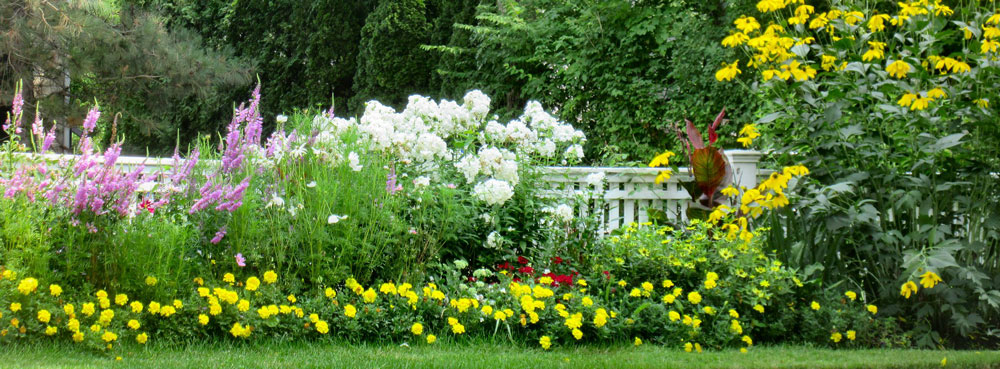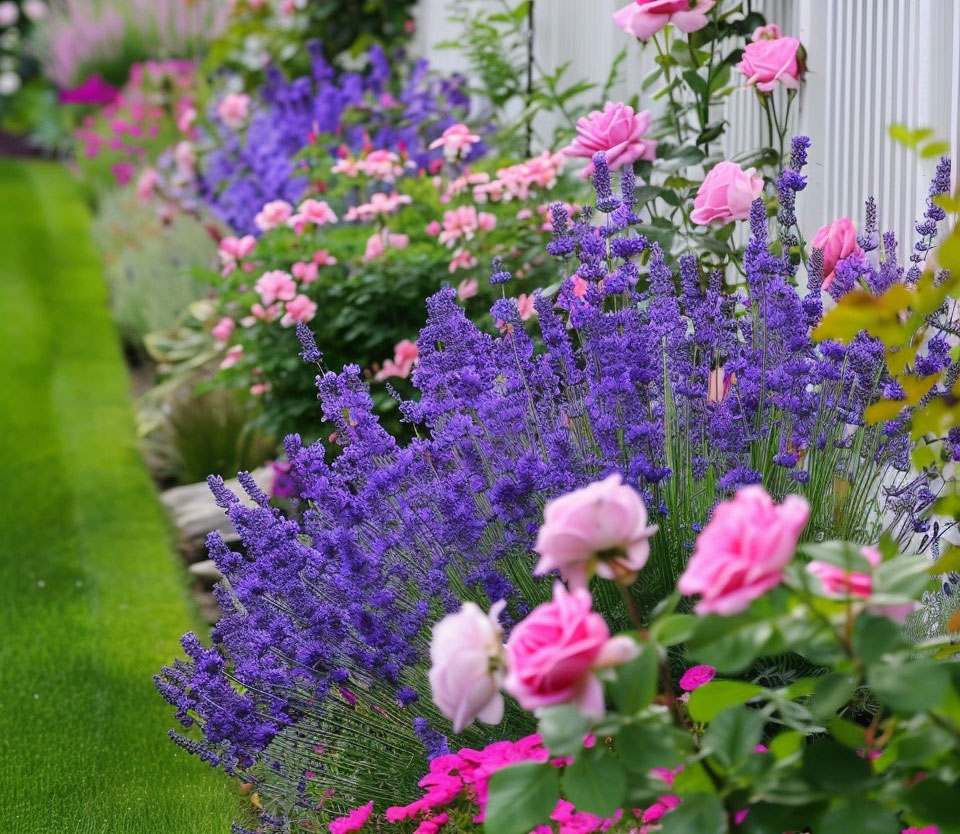
Designing a captivating and sustainable garden border is a combination of imaginative art and thoughtful science. By thoughtfully selecting and then artfully arranging your border plant choices, you can create a border that not only looks stunning but will thrive throughout the seasons. Regardless if you’re a seasoned gardener or just starting to explore gardening, the following expert tips, including specific plant recommendations, will help you create a sustainable and visually appealing garden border.
Understanding Your Site
The foundation of a magnificently attractive and long-lived garden border begins with a thorough understanding of your site. Before selecting your border plants, take the time to assess the following key factors:
- Soil Type: Identify whether your soil is sandy, silty, or clay-based. Understanding your soil type will enable you to choose plants that are best suited to thrive in your garden border conditions. Soil amendments may be necessary to broaden your available choices.
- Water Retention: Observe how your soil behaves in different seasons. Does it retain moisture during the winter, or does it dry out quickly in the summer? This knowledge will help to determine your plant selection, placement, and irrigational needs.
- Climate: Consider the amount of sunlight and rainfall your garden receives. These factors will greatly influence which plants will flourish in your environment.
- Space and Proportion: Ensure that the size and depth of your border harmonizes with the rest of your garden. The border should complement the overall design rather than dominate it, and should be pleasing to YOUR eyes, in terms of height, texture and color.
Selecting the Right Plants
Choosing the right plants is essential for a sustainable, low-maintenance garden border. Selecting perennial blooming plants will provide the lowest maintenance and long-lived viable environment. Here are some recommendations based on various needs:
- Drought Tolerance: In dry conditions, consider Sedum (Autumn Joy), known for its drought tolerance and succulent, fleshy leaves that add texture to any garden border. Other excellent choices include Lavandula angustifolia (English Lavender), with its aromatic foliage and spikes of purple flowers, and Achillea millefolium (Yarrow), a hardy perennial with feathery leaves and clusters of long-lasting flowers in various colors.
- Architectural Interest: Echinacea (Cheyenne Spirit), provides bold, upright stems and vibrantly-colored flowers, providing structure and long-lasting visual appeal. Additionally, consider Agapanthus africanus (African Lily), with its tall, striking stems and clusters of blue or white flowers, and Verbena bonariensis (Tall Verbena), which adds airy height with its petite clusters of purple flowers.
- Seasonal Appeal: Salvia (May Night) blooms from late spring to fall, providing a long season of purply-blue spikes that attract pollinators. For even more seasonal appeal, try Nepeta Walker Low (Catmint), with bluish-purple flowers that bloom from late spring to early fall, or Gaura lindheimeri (Whirling Butterflies), known for its delicate white or pink flowers that bloom throughout the summer.
- Wildlife Attraction: Asclepias tuberosa (Butterfly Weed) is a magnet for butterflies, with its bright orange flowers that bloom from summer to early fall. To attract even more wildlife, consider Monarda didyma (Bee Balm), which draws bees, butterflies, and hummingbirds, or Echinops ritro (Globe Thistle), with spiky, spherical blue flowers that are loved by pollinators.
- Texture and Form: Pair the delicate foliage of Coreopsis (Moonbeam) with the bold leaves of Hemerocallis (Stella de Oro) for a striking contrast that adds visual interest. For additional texture, consider Artemisia (Powis Castle), also known as Wormwood, with its silvery, finely cut foliage, or Brunnera macrophylla, aka Siberian Bugloss, which offers large, heart-shaped leaves and delicate blue blossoms in the spring.
Creating Effective Plant Combinations
Combining plants effectively enhances the beauty and interest of your garden border, both front and back:
- Height Variation: Combine the tall-growing Joe Pye Weed with lower-growing Coreopsis (Zagreb) to create a dynamic and visually engaging border. For more height variation, consider Digitalis purpurea (Foxglove), with its tall spires of bell-shaped flowers in delicious color combinations, or Delphinium elatum (Delphinium), which offers tall spikes of blue, purple, or white flowers.
- Color Coordination: Heuchera (Caramel) offers rich, caramel-colored foliage that softens the impact of brighter blooms like those of Echinacea (PowWow Wild Berry). To further enhance your color scheme, try Heuchera (Palace Purple), with its intense burgundy foliage, or Sedum (Matrona), which has rosy-pink flowers and gray-green foliage that will complement boldly-colored bloomers.
- Staggered Blooming Periods: In addition to spring-bloomers, consider adding Rudbeckia (Goldsturm) flowering from late summer through the fall, ensuring your border remains vibrant as the seasons change. Extend the blooming season further with Helenium autumnale (Sneezeweed), which offers late-summer to fall blooms in shades of yellow, orange, and red, or Aster novi-belgii (New York Aster), which produces late-season flowers in shades of purple, pink, and white.
- Incorporating Grasses: Panicum (Northwind) adds height and movement to your garden with its tall, airy seed heads, complementing other perennial bloomers without overwhelming them. Other grasses to consider include Miscanthus sinensis, also known as Maiden Grass (Morning Light), an exciting ornamental grass with its variegated foliage and feathery plumes, or Calamagrostis x acutiflora, more widely called Feather Reed Grass (Karl Foerster), an upright, narrow grass that adds complementary height, fascinating texture, and eye-catching movement.
- Ground Cover: Geranium (Rozanne) is excellent for filling in gaps, knitting together nicely to cover bare soil, and providing continuous color from spring to first frost. Additional ground cover options include Alchemilla mollis (Lady’s Mantle) with its soft, scalloped leaves and chartreuse flowers, and Ajuga reptans (Bugleweed, Creeping Bugleweed, Carpet Bugleweed, or Carpenter’s Herb), which offers dark periwinkle-blue blossoms and striking bronze or purple foliage.
Practical Tips for Border Success
To ensure your garden border thrives, consider these practical tips:
- Embrace Size: A densely planted border with robust perennials like Phlox (David) can naturally suppress weeds and reduce maintenance. You might also consider Baptisia australis (False Indigo), with its large, bushy form and spikes of rich blue, sunny yellow, or purply-gray flowers and Helianthus (Lemon Queen), which provides height and captivating color late in the season.
- Maintain Sharp Edges: Sharp edges provide a neat contrast to abundantly flowering plants like Shasta Daisy (Becky) that spill over with blooms. Other plants to maintain neat edges include Hemerocallis (Autumn Red), with its vibrant red blossoms, and Iris germanica (Bearded Iris), displaying sword-like leaves and sassy flowers in amazing colors.
- Consider Proportion: Keep your border proportional by combining larger plants like Daylily (Happy Returns) with smaller edging plants like Lavender (Hidcote). Other proportional combinations include Salvia nemorosa (Caradonna) with its slender spikes of violet flowers, and Dianthus gratianopolitanus (Cheddar Pink), a low-growing, fragrant bloomer.
- Plant in Groups: Groupings of Coreopsis (Early Sunrise) create a daring display that draws the eye and enhances visual impact. For more impactful combinations, try Phlox paniculata (Garden Phlox) bearing tall, fragrant, vari-colored flowers or a Hardy Geranium (Johnson’s Blue), which adds vibrant bluish-lavender color to the border.
- Patience Pays Off: Many perennials, such as Peony (Sarah Bernhardt) reach their peak in their third year, rewarding your patience with abundant blossoms. Other long-term, rewarding blooming plants include Dicentra spectabilis (Bleeding Heart), with its arching stems of heart-shaped flowers and Hosta (Sum and Substance), which puts on a show with prominent, bold foliage that becomes even more impressive as it matures.
Ongoing Maintenance and Evolution
A beautiful, sustainable garden border is a living, evolving space that requires ongoing attention:
- Editing: Be prepared to remove, divide, or relocate plants like Nepeta (Walker’s Low) if they overpower neighboring plants, ensuring balance in your garden. Additional plants that may require editing include Alchemilla mollis (Lady’s Mantle), which can spread vigorously, and Liriope muscari (Lilyturf), which is versatile and easy to move and propagate if it becomes too dominant.
- Continuous Assessment: Regularly evaluate and, if needed, replace plants like Echinacea (Magnus) to maintain the overall harmony and health of your border. Other plants to monitor include Coreopsis verticillata (Threadleaf Coreopsis), which may need replacing to maintain its vibrancy, and Lavandula stoechas (Spanish Lavender), which requires careful monitoring to stay healthy.
- Experimentation: Don’t hesitate to experiment with combinations like Hemerocallis (Stella de Oro) paired with Rudbeckia (Goldsturm) for unexpected and delightful contrasts, in both color and texture. You may also want to try Agastache (Blue Fortune) with its striking light, periwinkle-blue spikes, or Geum (Totally Tangerine), displaying bright orange blooms providing a fresh look when paired with contrasting or complementary colors.
Bringing It All Together
 Creating a beautiful garden border is a rewarding journey that combines creativity, knowledge, and just a little bit of patience. By understanding your garden’s unique characteristics and thoughtfully selecting plants that suit your environment and aesthetic goals, you can envision and create a border that offers visual appeal and seasonal joy throughout the year.
Creating a beautiful garden border is a rewarding journey that combines creativity, knowledge, and just a little bit of patience. By understanding your garden’s unique characteristics and thoughtfully selecting plants that suit your environment and aesthetic goals, you can envision and create a border that offers visual appeal and seasonal joy throughout the year.
Remember, a garden border is not a static feature but a living, evolving tapestry. As your plants grow and the seasons change, your border will naturally develop its own character. Embrace this evolution by regularly assessing your plant combinations, experimenting with new additions, and adjusting as desired.
Whether you’re aiming for a vibrant, wildlife-friendly space or a serene, structured display, these expert tips and plant recommendations will help you achieve stunning results. So, start planning, then grab your gardening gloves and tools, and watch your garden border flourish into a masterpiece of nature’s beauty with your own personal signature!





























































































































































































































































































































































































































































































































































































































































